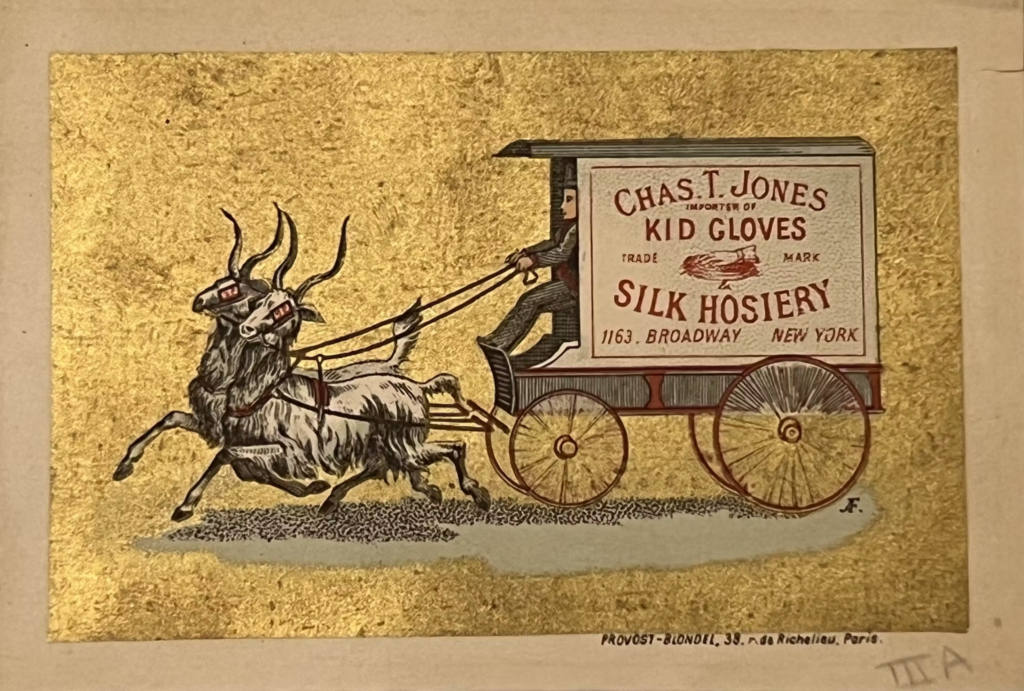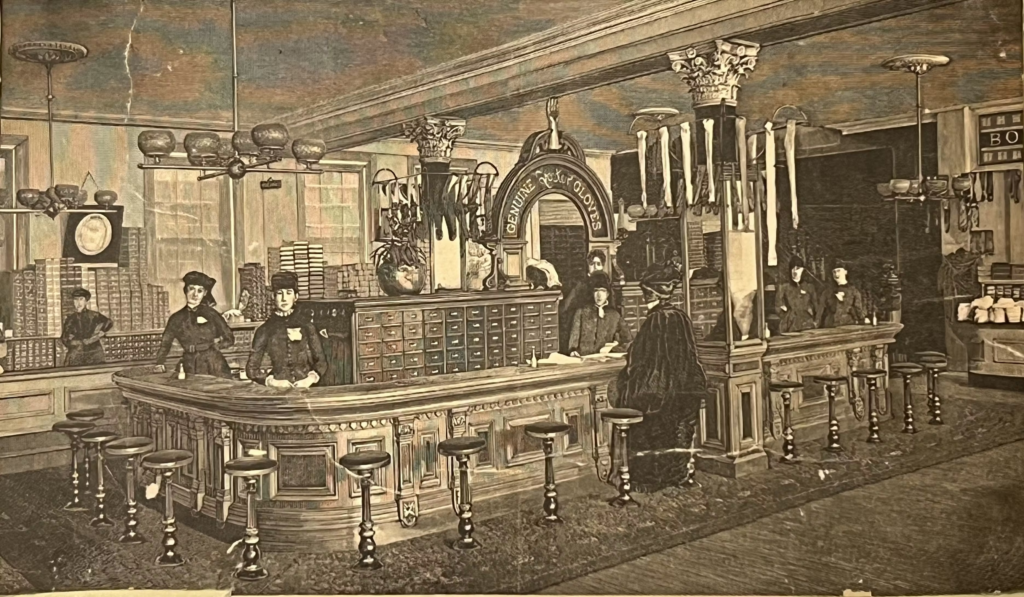Weekend, February 1, 2025 – Time to roll up your sleeves and wear elegant gloves


Finding Women in the Archives:
Ladies’ Gloves
Weekend, February 1-2, 2025
ISSUE #1383
NEW-YORK HISTORICAL SOCIETY
FROM THE STACKS
Do you have a pair of gloves on your holiday gift list?
If so, you’re part of a long-standing tradition of giving and receiving gloves. What you might not realize is that these simple accessories have a history that is intimately entwined with women’s social mores in American society. After all, who could forget the opening scene of Louisa May Alcott’s Little Women, when Meg decides to present Marmee with “a nice pair of gloves” for Christmas, instead of getting anything for herself?
Today, gloves are mostly cold-weather accessories, but in the 19th century middle-class and elite women wore gloves every time they left the house. These gloves were often made of silk or thin kid leather from the skin of a young goat or sheep, and meant to protect hands from sun rather than chill (for that, women often used fur-lined mittens or muffs). Gloves also helped keep the hands soft and “ladylike”; by the mid-19th century such soft, pale hands were the mark of a woman who didn’t have to do her own housework. Later on in Little Women, when Meg’s father returns from fighting in the Civil War, he praises her burnt, blistered, and needle-pricked fingers as evidence of her hard work, both on the home front and for the Union cause by cooking, cleaning, and sewing.

Paul Thompson, photographer. Rose O’Neill, 1914. Rose O’Neill Collection, PR-369, New-York Historical Society.
Her illustrations appeared in a number of notable periodicals including Harper’s, Life, Cosmopolitan, and a number of ladies’ home journals. Her success led to a full-time position with Puck, the humor magazine known for its political satire and anecdotes. While talented in various forms of art and continuing to freelance, it was the creation of one particular cartoon character that launched O’Neill into fame: the Kewpie Baby.
Chas. T. Jones advertisement, ca. 1895. Patricia D. Klingenstein Library, New-York Historical Society
Gloves made an excellent gift because a lady would need several different pairs in order to be properly outfitted. Kid leather was extremely delicate, prone to stretching, splitting, and tearing. Many of the most popular colors were also impractically light: white, fawn, tan, and gray were all considered “standard,” despite being terribly susceptible to stains. (Over the course of Little Women, the tomboy heroine Jo March ruins several such pairs of gloves with lemonade and coffee.) Moreover, women needed different gloves for everyday and evening wear. Evening gloves, especially those worn to the opera or to a concert, were often longer, and came with all sorts of different embellishments—they might be scented, ruffled, embroidered, beaded, or even printed with commemorative imagery to mark a very special occasion.


Left: Glove belonging to Elizabeth Shipton, 1850-1900. Kidskin, silk. New-York Historical Society, gift of Mrs. Edgar Saltus, 1917. 7ab. Right: Asher Durand, engraver. Glove worn at a ball to honor the Marquis de Lafayette, held at Castle Garden, September 14, 1824. Printed leather. New-York Historical Society purchase, Foster-Jarvis Fund, 1952.293.
However, a proper lady wouldn’t accept a gift of gloves from just anyone. Gloves could carry a hint of erotic charge: as British fashion historian Lucy Ellis writes, the glove “could provide a vital barrier between the sexes, preventing the frisson of touch and preserving modesty.” Returning once more to Little Women, this explains why Meg tells Jo, “Gloves are more important than anything else; you can’t dance without them,” before the sisters attend a fashionable party; and why we learn of Mr. Brooks’ romantic interest in Meg when Laurie reveals that he keeps one of her gloves in his breast pocket. It seems, then, that the exchange of gloves could be a sign of familiarity or intimacy. In the May 1852 issue of Godey’s Lady’s Book, the author claimed that this use of gloves hearkened back to a knightly time, when “chivalry wore [the glove] in its helm—at once a charm and token, the honorable badge of a woman’s love, invested with the potency of her virtues.”

Sole Agents for New York City of the Genuine Foster Hook Glove,” ca. 1884. Patricia D. Klingenstein Library, New-York Historical Society
The popularity and ubiquity of gloves also provided jobs for women. These charming images from the Bella C. Landauer Collection of Business and Advertising Ephemera show smartly dressed “shop girls” at work selling gloves, part of the great influx of young unmarried women into retail jobs between 1880 and 1890.
The reality of these jobs was slightly less charming—retail workers had to fight for things like seats behind the counter, and lunch breaks lasting beyond a scant 20 minutes amidst long work hours. The women who worked in glove manufacturing organized against long hours and poor working conditions: Agnes Nestor, who worked as a glove-maker in Chicago during the 1890s, recalled sewing a dozen pairs of gloves an hour (at five minutes per pair) and trying to break the monotony of the work by singing “A Bicycle Built for Two.” Nestor and the other women glove-workers objected to their employers’ practice of charging them for the needles, oil, and even the power required to run their machines, and walked out. Their demands were met, and Nestor later became a well-connected labor leader and president of the International Glove Workers Union of America, lobbying for workers’ education, maximum work hours, a minimum wage, and women’s suffrage.
As you wrap up your last-minute holiday shopping, we hope that you enjoy thinking a little bit about the history of this everyday object! The Center for Women’s History wishes you and yours a happy holiday season.
COMING TO THE NYPL BRANCH ON
FEBRUARY 18TH
WHEN MANHATTAN WAS DUTCH—THE
400TH ANNIVERSARY EDITION
The Dutch of the early 17th century turned an edge of Manhattan wilderness into New Amsterdam. Although it lasted only 40 years, the colony had a profound and lasting impact on the future city of New York. From the start, people of many ethnicities filled its streets, trade and profit were paramount, and religious tolerance was the norm.
With Joyce Gold- Historian and noted NYC Tour Guide
This program is free and open to the public.
TIme: 6:30 p.m.
PHOTOS OF THE DAY

Talking about games, here is one that is not available (except on E-bay).
The reporter and famous investigator of the Blackwell’s Island Lunatic Asylum later went on to circumnavigate the world.
CREDITS
NEW -YORK HISTORICAL SOCIETY
FROM THE STACKS
Jeanne Gutierrez, Curatorial Scholar, Center for Women’s History
All image are copyrighted (c) Roosevelt Island Historical Society unless otherwise indicated
THIS PUBLICATION FUNDED BY DISCRETIONARY FUNDS FROM CITY COUNCIL MEMBER JULIE MENIN & ROOSEVELT ISLAND OPERATING CORPORATION PUBLIC PURPOSE FUNDS.


Copyright © 2024 Roosevelt Island Historical Society, All rights reserved.Our mailing address is:
rooseveltislandhistory@gmail.com

Leave a comment